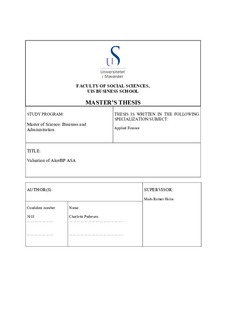| dc.contributor.advisor | Holm, Mads Rømer | |
| dc.contributor.author | Pedersen, Charlotte | |
| dc.date.accessioned | 2018-09-21T13:37:44Z | |
| dc.date.available | 2018-09-21T13:37:44Z | |
| dc.date.issued | 2018-06 | |
| dc.identifier.uri | http://hdl.handle.net/11250/2563959 | |
| dc.description | Master's thesis in Applied Finance | nb_NO |
| dc.description.abstract | This master thesis conducts a valuation of Aker BP in order to determine the company’s fair value. First, the industry of oil and gas is explained, and the history and current state of Aker BP is established. Then strategic analyses of the macroeconomic and microeconomic environment were conducted. A macroeconomic analysis was conducted trough looking at economical variables, political impacts and environmental factors. For analysing the microeconomic impacts a SWOT-analysis were used. Since a merger created Aker BP, an analysis of the synergy effect between the merged companies was also a part of the research in this thesis.
An analysis of the financial statements was performed to contribute to establish a forecast of Aker BP’s future expected state. Moreover, the forecast was used to create a forecasted future cash flow, which was then discounted in order to value the company by a fundamental valuation. The discount rate was estimated by calculating a weighted average cost of capital. Based on the fundamental analysis the estimated price per share was 14.59 USD compared to the market share price from Oslo Stock Exchange of 27.08 USD at 28th of March.
After the fundamental analysis a sensitivity analysis were conducted to test the affect of changes in revenues, capital expenditure and weighted average cost of capital. The analysis showed that the share price was highly affected by changes in capital expenditure and weighted average cost of capital, and less affected by changes in revenues.
As a last part of the thesis a relative valuation by the use of comparable multiples were conducted. First, a set of comparable companies was selected. The multiples used in the analysis were P-multiples such as price-earnings-ratio and price-to-book ratio, and enterprise value multiples such as EV/EBIT, EV/EBITDA and EV/Revenue. By comparing the calculated multiples Aker BP was shown to have higher multiples than the average of the industry. The results could be interpreted to support the findings through the fundamental valuation.
Based on the valuation conducted in this master thesis an investor was not recommended to buy the stock of Aker BP since the estimated fair value of were lower compared to the price in the market. | nb_NO |
| dc.language.iso | eng | nb_NO |
| dc.publisher | University of Stavanger, Norway | nb_NO |
| dc.relation.ispartofseries | Masteroppgave/UIS-HH/2018; | |
| dc.rights | Navngivelse 4.0 Internasjonal | * |
| dc.rights.uri | http://creativecommons.org/licenses/by/4.0/deed.no | * |
| dc.subject | økonomi | nb_NO |
| dc.subject | administrasjon | nb_NO |
| dc.subject | valuation | nb_NO |
| dc.subject | verdivurdering | nb_NO |
| dc.subject | anvendt finans | nb_NO |
| dc.title | Valuation of Aker BP ASA | nb_NO |
| dc.type | Master thesis | nb_NO |
| dc.subject.nsi | VDP::Samfunnsvitenskap: 200::Økonomi: 210::Bedriftsøkonomi: 213 | nb_NO |

